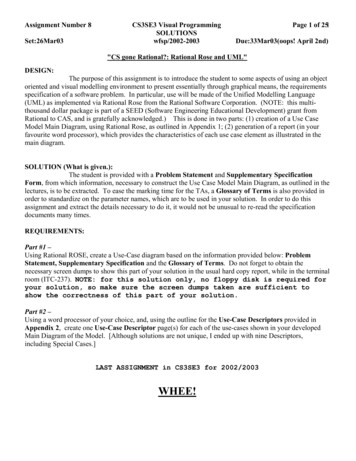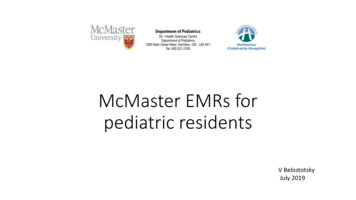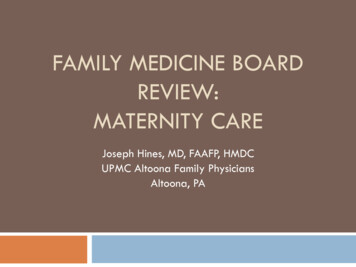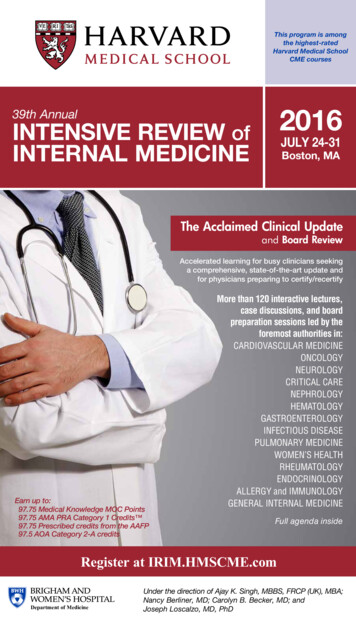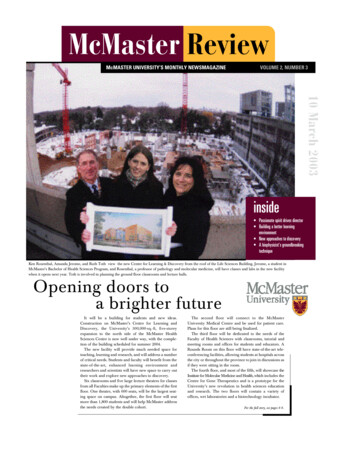
Transcription
McMaster ReviewMcMASTER UNIVERSITY’S MONTHLY NEWSMAGAZINEVOLUME 2, NUMBER 3inside Passionate spirit drives director Building a better learningenvironment New approaches to discovery A biophysicist’s groundbreakingtechniqueKen Rosenthal, Amanda Jerome, and Ruth Toth view the new Centre for Learning & Discovery from the roof of the Life Sciences Building. Jerome, a student inMcMaster’s Bachelor of Health Sciences Program, and Rosenthal, a professor of pathology and molecular medicine, will have classes and labs in the new facilitywhen it opens next year. Toth is involved in planning the ground floor classrooms and lecture halls.Opening doors toa brighter futureIt will be a building for students and new ideas.Construction on McMaster’s Centre for Learning andDiscovery, the University’s 300,000-sq.-ft, five-storeyexpansion to the north side of the McMaster HealthSciences Centre is now well under way, with the completion of the building scheduled for summer 2004.The new facility will provide much needed space forteaching, learning and research, and will address a numberof critical needs. Students and faculty will benefit from thestate-of-the-art, enhanced learning environment andresearchers and scientists will have new space to carry outtheir work and explore new approaches to discovery.Six classrooms and five large lecture theatres for classesfrom all Faculties make up the primary elements of the firstfloor. One theatre, with 600 seats, will be the largest seating space on campus. Altogether, the first floor will seatmore than 1,800 students and will help McMaster addressthe needs created by the double cohort.The second floor will connect to the McMasterUniversity Medical Centre and be used for patient care.Plans for this floor are still being finalized.The third floor will be dedicated to the needs of theFaculty of Health Sciences with classrooms, tutorial andmeeting rooms and offices for students and educators. ARounds Room on this floor will have state-of-the-art teleconferencing facilities, allowing students at hospitals acrossthe city or throughout the province to join in discussions asif they were sitting in the room.The fourth floor, and most of the fifth, will showcase theInstitute for Molecular Medicine and Health, which includes theCentre for Gene Therapeutics and is a prototype for theUniversity’s new revolution in health sciences educationand research. The two floors will contain a variety ofoffices, wet laboratories and a biotechnology incubator.For the full story, see pages 4-6 .
Daily News ExpressTAAGREEMENT RATIFIEDcMaster's teaching assistants (TAs) and the University ratified a newcollective agreement in February.The new 28-month collective agreement provides for wage increases to thegraduate, undergraduate student rate. Other adjustments include equating thefifth and subsequent years doctoral rate to the graduate rate by nextSeptember, and increasing the rate for all others covered by the agreementsuch that it is level with the undergraduate rate by Sept. 1, 2004.There were also increases to the dental benefit and to the benefit fund thatis administered by the union.MBONEY WINS MSU RAC ENeville Boney has been elected the 2003-04 president of the McMasterStudents Union (MSU). He won a close race on the sixth ballot ofpreferential voting with a total of 1,607 votes. Boney, who has a degree inkinesiology and has finished year one of a second degree in French, iscurrently vice-president administration for the M SU.DANCEMOF THE LIONcMaster’s Chinese Students Association, one of the largest and oldeststudent organizations on campus, celebrated the Chinese Lunar NewYear with a traditional Lion Dance on Feb. 5.As part of this tradition, McMaster President Peter George, McMasterStudents Union president Evan Mackintosh and Luke Chan, executive director of the Office of International Affairs, dotted the lions' eyes prior to thedance to awaken the lions' spirits. This was the first time in the 36-year-oldassociation’s history that it has celebrated the traditional Lion Danceon campus.BUILDING A MOREINCLUSIVE COMMUNITYssues of diversity, inclusionand equity will gain a higherprofile at McMaster with therecent establishment of a presidential advisory committee.University President Pe t e rGe o r g ec r e a t e d the President’sAdvisory Committee on Buildinga n I n c l u s i v e Community aspart of his and McMaster’s commitment to a community thatcelebrates, fosters and respectsdiversity.“The University fosters anenvironment of diversity andinclusivity. It is part of our culture and is something we shouldall celebrate,” says George.“One of our principal purposesas a University is to make possible the expression of a widerange of views, cultures andlifestyles. It is my hope that thiscommittee will help to strengthen our commitment to theseissues and will assist us in building a stronger, more inclusivecommunity for all.”The committee will act as anadvisory body to the Presidenton a variety of issues, including :Ilrecommending strategiesto identify and eliminatepractices which may havethe effect of beingdiscriminatory,lproviding a forum for theadvancement of issues relevant to diversity, inclusionand equity; andPENSION SURPLUS DISTRIBUTEDhe distribution of McMaster’s pension surplus took place in Februaryfollowing a green light from the Financial Services Commission ofOntario (FSCO).Discussions between the McMaster Employees' Surplus Sharing Committeeand the University over the distribution lasted more than four years. Duringthe negotiations, the University and the committee (representing approximately 4,500 pension plan members) agreed that each group would share the 150-million surplus – 75 million to be returned to plan members, includingpensioners, and 75 million to be returned to the University to fundother initiatives.TBATTLINGMcMaster is battling plagiarism with Turnitin.com, a computer softwarepackage designed to reveal cheating. Turnitin.com is used by a numberof Canadian universities, including the University of Western Ontario, theUniversity of Toronto and York University.With Turnitin.com, faculty members register onto its Web site and submit acourse assignment. Students then submit their papers electronically and handin a hard copy to their professor. The papers are compared to billionsof pages of content located on the internet and in its own databases. Within24 hours, professors receive an "originality report" containing the results ofthose comparisons.These stories are excerpted from the McMaster Daily News Web site.For additional details or to read other McMaster news, visit h t t p : / / d a i l y n e w s. m c m a s t e r. c afacilitating communicationand co-ordination on campus among those groupsand bodies that are interested in advancing theprinciples of diversity.The committee will be developing a statement embodyingMcMaster’s commitment todiversity.The committee is co-chaired byUniversity Provost Ken Norrie andMcMaster Students UnionPresident Evan Mackintosh,and consists of representativesfrom numerous campus groupsand organizations, including:the Senate Committee on HumanRights, the MSU Committee onHuman Rights, the OmbudsOffice, the Sexual H a r a s s m e n ta n d A n t i -Discrimination Office,the facu l t y, staff, graduate students, and part-time studentsassociations, Women’s Studies,The Gay, Lesbian Bisexual andTransgendered Centre, theAnti-Violence Network, PeaceStudies, and many others.“This committee is veryimportant to the University andI’m pleased to be co-ch a i ring it with the M SU president.McMaster already has a number of initiatives in place whichencourage and foster diversity.In bringing these groups together we have an opportunity collectively to build on theseachievements,” says ProvostKen Norrie.Our mistakeOur apologies to biology professor Ita O’Kelly, whose name we misspelled inour last issue. O’Kelly was one of a number of professors who were interviewed for our feature on faculty renewal. We regret any inconvenience orembarrassment the error may have caused.Volume 2, Number 3 March 10, 200 3PL A GI A RISMlPublished by:Office of Public RelationsRoom 111, Chester New HallMcMaster University1280 Main St., W.Hamilton, Ontario L8S 4L9Fax: 905-521-1504E-mail: review@mcmaster.caThe Review is published monthly (except July)for faculty, staff and students at McMasterUniversity.The editor reserves the right to limit, select, editand position submitted copy and advertisements. Views expressed in the Review do notnecessarily reflect University policy.Comments and letters should be sent to:Kelly Curwin, editor, 905-525-9140, ext. 23662;e-mail: curwink@mcmaster.ca. Letters to theeditor must include name, department or addressand phone number.McMaster Review 2 10/03/03Vice-President, University Advancement:Roger TrullDirector, Public and Government Relations:Andrea FarquharAssociate Director, Public Relations:Jayne JohnstonEditor: Kelly CurwinContributors: Shelly Easton, Susan Emigh, ElaineHujer, Julia Thomson, Chantall Van RaayPhotography: Chantall Van RaayDesign and Production: Kristy PaoneAdvertising: Pat MiladinDeadlines: All art and ads are due on the firstFriday of every month in the month precedingpublication. Publication dates:April 7, May 5, June 2, Aug. 5, Sept. 8, Oct. 6,Nov. 3, Dec. 8McMaster University and its employees andagents assume no responsibility for damage,errors or omissions related to this publishedmaterial or for dissatisfaction with goods orCopyright 2002services advertised herein .
Staff ProfileShe’s a team player with a passionate spiritand a strong allegiance to communityAthletics & Recreation director Therese QuigleyBYELAIN E H UJERherese Quigley, McMaster's director ofAthletics & Recreation, feels "very blessed"to have lived and worked in McMaster's supportive community for 18 years. And her best years,she vows, are still ahead of her.Quigley's drive and enthusiasm, along withexceptional teaching, coaching and managementskills have brought her a long way. Growing up inLondon, Ontario, in a family of seven children, sheremembers sports as her earliest passion. From theage of six, she played competitively and by hertwelfth year, tennis had become the major focus.She says, "There were public courts about ablock and a half from me and London had a verygood junior development program. You didn't haveto be wealthy to play and many of the players didnot come from families who could afford to paymembership fees. A lot of them became tennis professionals. We played at a high level; it was verycompetitive. Clearly, my whole career grew fromthe sporting experiences I had at a young age.”Quigley notes, however, that in those days, therewere few opportunities for girls to participate in anykind of team or structured sports. It wasn't untillater, while she was attending high school and at theUniversity of Western Ontario, that girls and womenwere provided more options to compete in a varietyof sports. There, she switched her allegiance to volleyball (where she was named the school’s FemalePlayer of the Year in 1975) and played on the Canadiannational volleyball team from 1972 to 1974. S h esees this as a significant period of transition."My personality really led me to be interested inteam sports. There is nothing like accomplishingsomething in a team. Why it's so satisfying is hard to putinto words, but it's a very different sense of accomplishment. Perhaps coming from a large family, youlearn the value of co-operation, of working thingsout . Certain personality types are very interactiveand I just find the team concept very appealing."After teaching high school in London for fouryears, Quigley completed her MA at the Universityof Alberta. She came to McMaster in 1984 as headcoach of the women's varsity volleyball team andlecturer in the School of Physical Education &Athletics. In the early nineties, when the Department ofKinesiology separated from Athletics & Recreation,she had to make a choice."The two diplomas are very different," she says,"and I went where my heart was, where I felt I couldmake the greatest contribution. I've been veryhappy with my decision."Something of a trailblazer, in 1990 Quigleybecame the first woman director of athletics andrecreation in Ontario. She happily notes that, now,40 per cent of the schools in Ontario have women asathletic directors. In 1993, The Sports Network( T S N) established an award in Quigley’s name,r e cognizing the three-time Ontario Women’sTTHERESE QUIGLEY IS THE CONSUMMATE SPORTS FAN AND VOLUNTEER.(TSN)T HE S PORTS N ETWORKESTABLISHED A STUDENTAWARD IN HER HONOUR IN THEEARLY1990S.Interuniversity Athletic Association Coach of theYear’s leadership in and contribution to sport. TheTherese Quigley/TSN Leadership Award is presented annually to a female student-athlete who hasexhibited outstanding achievement in three areas:volleyball, academics and community involvement.In 1994, she was named Hamilton's Woman of theYear in Sport, Health and & Fitness. Last November,Sheila Copps presented her with a Spirit Award forher contributions to sports in Hamilton.She's grateful for the recognition, but one of herproudest achievements is the work of the Department ofAthletics & Recreation in establishing The PulseFitness Centre."We had this old weight room in the sub-basement. The air quality was poor and the space wasn'tmeeting the needs of students. We converted it intoThe Pulse and it went from being archaic to a stateof-the-art facility. Participation levels have g r o w nwell beyond the capacity of our current facili-McMaster Review 3 10/03/03ty and we have been working on a facility expansionfor several years. The growing numbers are reflective of the entire program, not just The Pulse."That opportunity for expansion will come,Quigley believes, with her current pre-occupation,the 2 010 Commonwealth Games bid. She is optimistic about Hamilton's chances of hosting theGames and speaks eloquently about the benefits thatthis will bring to McMaster and to Hamilton.“The legacy left here in Hamilton and atMcMaster will be tremendous and the Games willgive us an opportunity to demonstrate to theCommonwealth what Hamilton and McMasterhave to offer. We only have to look to Edmonton,Alberta to see the impact of hosting theCommonwealth Games. People still refer to theGames held in Edmonton in 1978 as being transformational – a renaissance in the community. TheCommonwealth Games were a catalyst for growthand development; they gave the city an opportunityto position itself in a more international forum."Quigley sits as a volunteer on the bid committeefor the Games and expects that voluntarism willcontinue as a natural and necessary part of her life."When people ask me what I like best aboutmy job, I always say, after five and weekends.Everyone laughs, but then I explain: that is whenall the teams compete and everything comes alive.My regular job is like any other. It has its rewards.But involvement with sport is what I love to do. Ifi t w a sn 't my c a r ee r , I' d b e th e re a s a vo l u n t e e r. No matter how old I am, I know I'mgoing to be involved."
Cover StoryBuilding a betterlearningenvironmentB Y K E L LY C U R W I NOpportunities to build custom, state-ofthe-art classrooms for studentsdon’t come along very often.Planning for the ground floor of thenew Centre has centred on the development of new lecture theatres and classrooms, andensuring these new facilities are physically comfortable, aesthetically appealing and technologicallys u p e r i o r. The goal is to create a better learninge n v ironment, a better classroom, for students. Thefacilities on this floor will be available to all students.“Our students will find these new lecture hallsvery appealing,” says Ruth Toth, assistant registrarscheduling and examinations, who has beeninvolved in the planning. We know it’s important toprovide an attractive learning environment for students, especially in large classrooms. These newfacilities will definitely do that.”In all, this floor will house five (or six) large lecture halls. The largest will seat 600 students and,with the push of a button, can be split into two smaller lecture theatres of 300 seats each.Several McMaster professors met with the architects to discuss the new facility and specific educational needs.School of Geography & Geology instructorCarolyn Eyles was thrilled to have the opportunityto identify design features and elements that wouldenhance the student learning experience. “We talkedto the designers and architect about the kinds ofneeds we foresaw for dealing with large classes. Oneconcern we had is that a large room limits theinstructor’s ability to involve the students in the lecture and we also felt it was important that studentsbe able to interact with one another and with theirprofessor even in a large lecture setting.” To addressthe latter concern, the seats in the lecture hall willhave a 90-degree turnout, which will enable studentsto form groups within the classroom, with studentsboth beside and behind them.“It’s very, very exciting to actually have instructors involved in this process,” says Eyles, an awardwinning professor. “The ability for students to dosomething in a lecture room where they are actuallyengaged in the learning, is very important.” She saysthe new lecture theatres will make it easier for faculty to adopt and apply new and different teachingstrategies for teaching to large classes (for example,doing small group work in a large lecture hall).The lecture theatres will be equipped withd e l u x e mobile multimedia cabinets that will make iteasy for instructors to provide information in a multitude of formats for students – from very basicoverhead projector displays to more complex digitalimages and video clips.One noteworthy and interesting feature currentlybeing explored is the installation of a special projec tor and video screen in one of the lecture theatresthat would enable 3-D visual displays of images ofthe galaxy and the inner workings of the body.Students would wear 3-D glasses to gain a threedimensional view of images projected both vertically and horizontally on the screen.“The new Centre for Learning & Discovery willbe arriving at a pretty good time when you considerthe current growth in post-secondary enrolment,partially due to the double cohort group,” saysAmanda Jerome, a third-year Bachelor of HealthSciences Program student who will be among thefirst to use the new building.“Right now the Bachelor of Health SciencesProgram has nowhere to call its own. This (newbuilding) will fill that gap. Many of us find that thelibrary is our only option for meetings. The newclassrooms and tutorial rooms will be better forthese kind of group meetings and it will also be greatto study in a building that has hospital and researchlabs available.”As administrator of academic services for theFaculty of Health Sciences, Roberta Shaw hashelped to plan and develop the third floor of thenew Centre. It’s precisely students like Amanda thatShaw and fellow planners in the Faculty had in mindwhen it came to planning the facility.“We are building eight meeting rooms to accommodate 22 to 25 people each and they’re going to beused by our graduate students and students in theBachelor of Health Sciences Program when theyhave their inquiry groups.” Shaw says most facilitieswill be outfitted with state-of-the-art components,such as digital technology, multimedia podiums andinternet access.The education and research divisions inh e a l t h sciences will share the third floor; one-half ofthe total 37,500-sq. ft. floor space will be d e v o t e dto e d ucational needs: four new classrooms, 10 tutorial rooms and eight inquiry group rooms will beconstructed. Th e s p ac e w i l l a l s o h o u s e t h ePr o g r am f or Ed u c a t i o n al Re s e a r ch a nd De v e l o p m e n t, t he Fa c u l t y De v e l o p m e nt ProgramandMcMaster Review 4 10/03/03the Continuing Health Sciences Educ
McMaster Review 2 10/03/03 TA A G REEMEN T R AT I FIED McMaster's teaching assistants (TAs) and the University ratified a new collective agreement in February. The new 28-month collective agreement provides for wa
